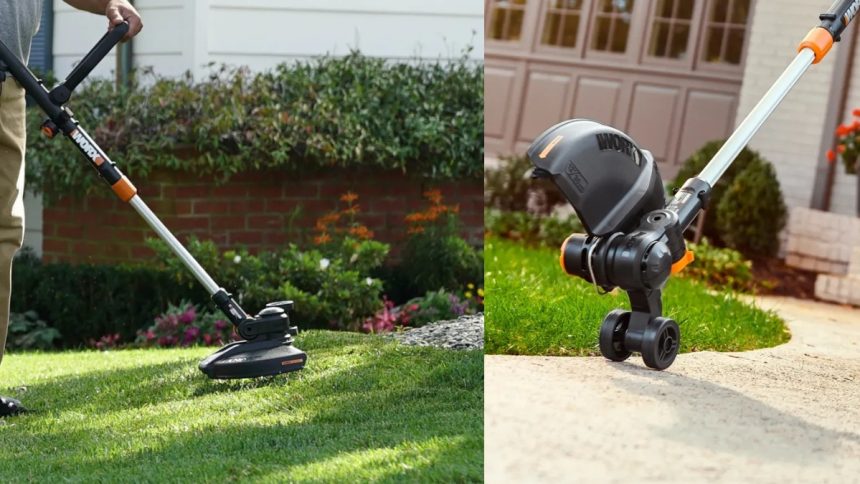Ever notice how even after mowing the lawn, something still feels off? The middle looks great, but the edges around trees, fences, or the sides of your house always seem kind of rough. That’s because your regular mower isn’t built for those weird corners or tight spaces. No matter how hard you try, it just won’t get every blade of grass. That’s where a different kind of tool steps in—the weed wacker.
Why Lawns Always Have Those Problem Areas
Most people think a lawnmower is all they need to keep their yard in shape. And sure, it’s great for wide-open spots. But lawns aren’t perfectly flat open spaces. They have edges, cracks, flowerbeds, and spots under bushes where grass still grows. It’s those places where the mower gives up.
Around trees, lamp posts, fences, or the edge of a patio—those are classic trouble zones. Even the sharpest mower can’t hug a curved wall or slide under a low-hanging hedge. So what happens? The grass in those spots keeps growing, and it ends up looking messy. That’s why sometimes, even after mowing, the lawn still looks unfinished.
The Tool That Goes Where Mowers Can’t
This is where a weed wacker makes all the difference. It’s a handheld power tool with a spinning nylon line that slices through grass and weeds. Because it’s lightweight and easy to move around, it can reach the spots your mower skips over.
If you’re thinking about trying one out, there’s a whole range of weed wacker options that are built to handle everything from tiny yard edges to heavy weed patches. They’re made for people who want their yard to look clean without spending all weekend on it.
Some models even flip into edgers, which means they can also cut those super-sharp lines where your lawn meets a sidewalk or garden bed. It gives the whole space a tidy, professional look without any extra tools.
What Makes a Weed Wacker So Useful
It’s not just about getting into tight corners. Weed wackers are super handy for other reasons too. First, they’re quick. You can cover a lot of ground in a short time. Plus, they’re easy to store and don’t need as much setup as a mower.
Some run on rechargeable batteries, which is great if you’re trying to avoid gas smells or cords. You just grab it, hit the button, and start trimming.
They’re also really good for cutting tall weeds and thick patches where the grass has started growing through rocks or cracks. A mower would struggle—or not even reach those spots. A weed wacker slices right through without a problem.
Common Weed Wacker Mistakes (and How to Avoid Them)
Even though weed wackers are simple to use, a few mistakes can mess up your yard fast. One is cutting too low. It’s easy to dig into the dirt by accident, which can leave behind bare patches or even gouge out chunks of your walkway or fence. Keep the line floating just above the ground.
Another thing to watch out for is safety. That spinning line moves fast and can kick up bits of rock or bark. It’s smart to wear safety glasses and closed shoes. And before starting, do a quick scan of the area. A hose, wire, or small toy hidden in the grass can get shredded if you’re not careful.
Electric vs. Gas: What Works Best at Home
Older weed wackers mostly used gas, but now a lot of people go for electric ones. They’re lighter, quieter, and way less messy. For most yards, a battery-powered trimmer has all the strength you’ll need—and no fumes to deal with.
Gas versions still exist and are useful if you’ve got a huge yard or really thick brush. But unless you’re dealing with serious overgrowth, electric is easier to use and more convenient overall.
How Often Should You Use One?
There’s no strict rule, but a good plan is to trim every time you mow, or at least every other mow. It keeps those wild edges under control. Waiting too long can make trimming harder because the grass gets tangled and thick.
Some weeks, you might not need to mow but still notice scruffy corners. That’s when a quick trim with the weed wacker makes everything look fresh again without a full yard session.
One Tool, a Big Difference
It’s kind of funny how a small tool can have such a big impact. Even if the center of the lawn is perfectly cut, rough edges can make the whole thing feel messy. But after one lap with the weed wacker, everything looks crisp.
It also makes you look like you know what you’re doing—even if you’re not a lawn expert. Clean lines and smooth edges give the yard that finished, cared-for look. And it only takes a few minutes.
What to Remember
A weed wacker fills in all the gaps your lawnmower leaves behind. It’s made for edges, corners, and tight spots that are impossible to hit with wide mower blades. If your yard always feels just slightly messy no matter how often you mow, it might be because the edges aren’t getting trimmed.
The good news? That’s an easy fix. A good weed wacker can clean up those messy spots and make the whole lawn feel brand new.
Time to Try It Yourself
Yard work doesn’t have to take forever. A weed wacker makes the job faster, easier, and way more satisfying. The next time you finish mowing and something still feels off, check the edges. That’s probably where the problem is—and now you know exactly what can handle it.
Lynn Martelli is an editor at Readability. She received her MFA in Creative Writing from Antioch University and has worked as an editor for over 10 years. Lynn has edited a wide variety of books, including fiction, non-fiction, memoirs, and more. In her free time, Lynn enjoys reading, writing, and spending time with her family and friends.















